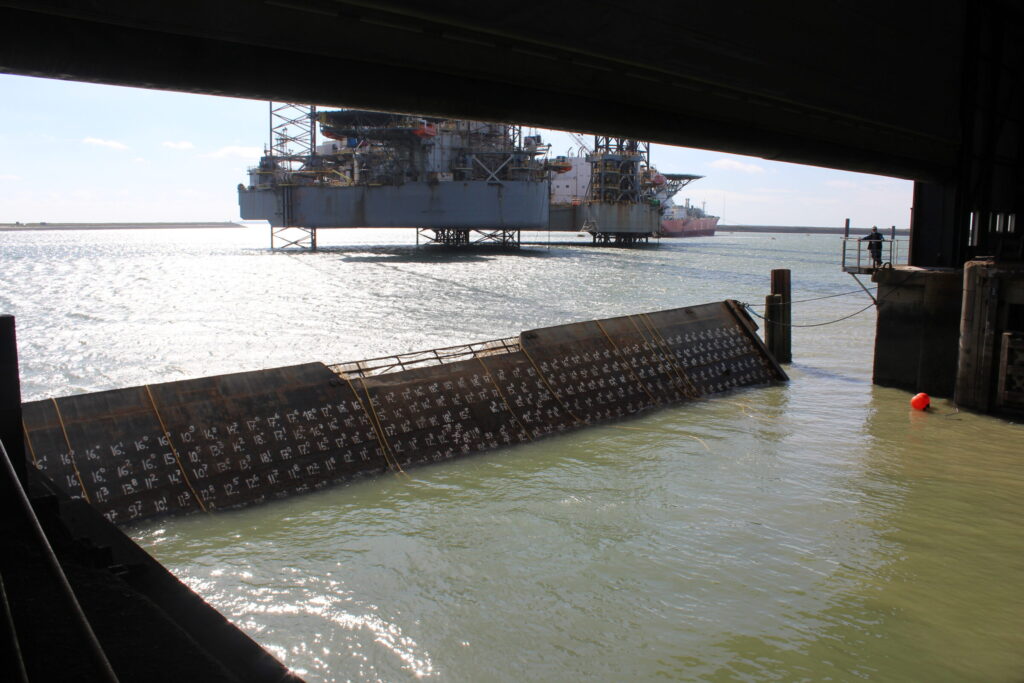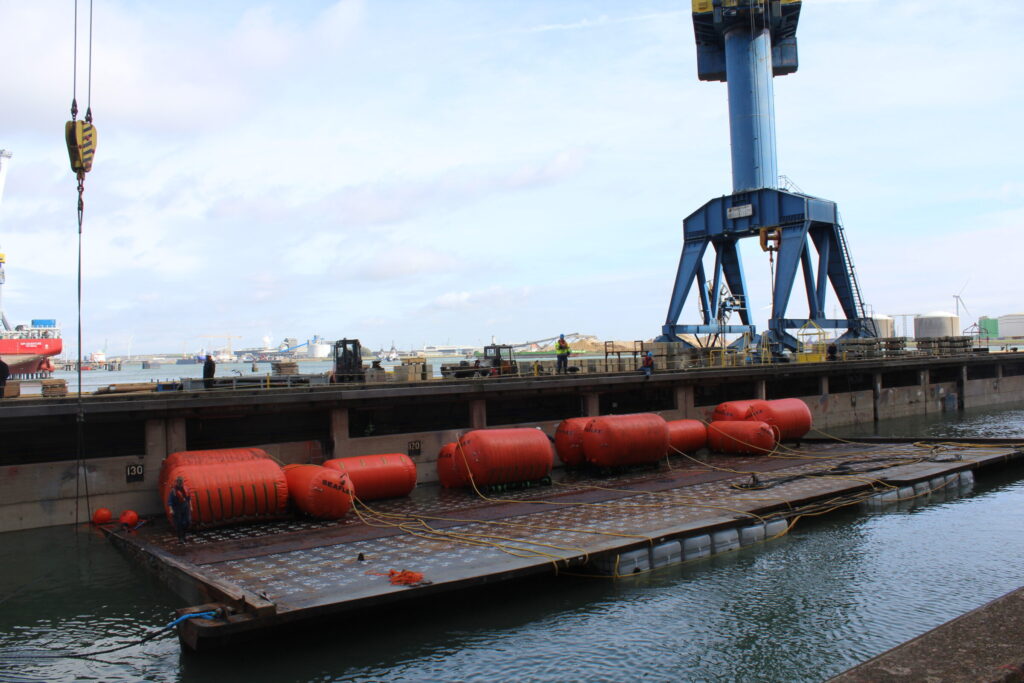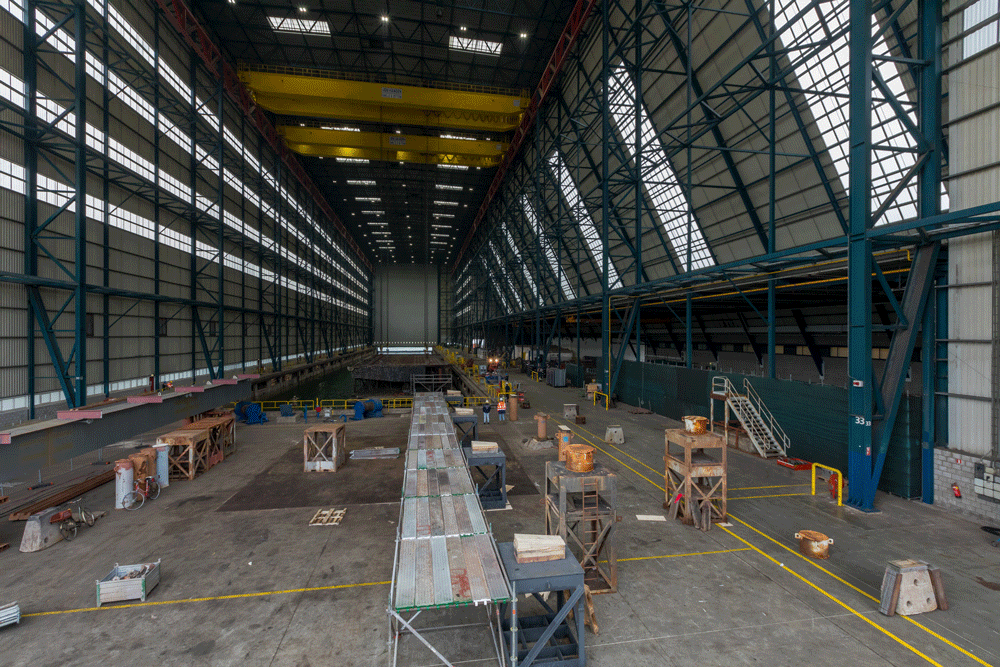The dock door weighing more than 200 tonnes in Dock 2 at Damen Shiprepair Vlissingen is as good as new. A team of forty people completely repaired the colossal structure in just eleven days. “The door is now good to go for a few years more,” says a satisfied Wim van de Velde, who supervised the job as Project Manager. During those eleven days, work on the project was non-stop, in alternating day, evening and night shifts. The job had to be done exactly between two periods of spring tide.
The repaired dock door dates from the early 1960s. DSV had been planning to refurbish the door for some time. The job officially started on 23 September, but a lot of preparation work was needed first, Wim explains. “Several parts of the door were in a poor state; they had to be replaced. Before we started the job, we built new, replacement sections for those parts. So, the old pieces were cut out of the door, and the new ones put in.”
One of those new sections weighed a whopping 25 tonnes and was 28 metres long. The two other replacement sections weighed 3.5 tonnes each; these were the two lifting points to which the chain that you use to pull the door shut attaches. According to Wim, many smaller pieces of steel were also replaced. “In total, you’re talking about forty tonnes.” The whole project went very well, Wim says, but of course there were also challenges. “After we had removed the dock door on 23 September, ZMC Industrial & Maritime Cleaning spent two days removing fouling from the steel door. We’re talking things like shells, barnacles, seaweed.”
 The dock door weighing more than 200 tonnes was repaired in just eleven days.
The dock door weighing more than 200 tonnes was repaired in just eleven days.
“They scraped 55 cubic metres of fouling off the door. To give you an idea: the door itself originally weighed 220 tonnes, but when we lifted it out, it weighed 245 tonnes with the fouling included. After it had been stripped of barnacles and shells and completely cleaned, it weighed 230 tonnes. Then about ten tonnes of additional rubbish were removed, mainly shells that were growing in between the small support beams, for example. So now the door is back to its original weight.”
Another challenge was to make the door floating. Wim: “On the underside of this huge structure are pipes and tanks. Those pipes had to be replaced. These tanks are normally filled with fresh water. To be able to get a door out, you have to empty the tanks one by one using air, so that the door can start floating and you can eventually get it out. Diving inspections had shown that the lower tanks were leaking. So, we could not create the buoyancy needed to lift the door out. We then decided to hang special air bags on the dock door; the same bags that are used when salvaging ships.”
 The repaired dock door dates from the early 1960s.
The repaired dock door dates from the early 1960s.
“We were then able to make the door float out of its hinges on these air bags, something that you normally do using those tanks. In total, we used fifteen airbags with a combined volume of 120 tonnes.” Wim explains that all the woodwork in the dock door has also been replaced. It’s the wood, together with rubber seals, that sits against the concrete and keeps the door watertight. “A completely new seal has been made.”
All the work of removing and replacing the dock door took from the end of September to the beginning of October. The steelwork took up the most time: eight days out of the eleven. A team of forty people worked continuously, day and night. Accomplishing such a job in eleven days is very fast, but there was no other way, Wim explains, “because we had to do the work exactly between two periods of spring tide. If you do it during spring tide, damage may occur. The seawater comes over the walls, which is a problem, because that’s where the electricity is. The choice of a quieter period to renew the dock door was deliberate. “There will soon be a number of ships in Dock 2, so the project had to be finished before they arrived.”
Wim is pleased that it all worked out. “There are always snags and hitches, and afterwards you sometimes think: maybe this or that should have been done differently, but it’s always nice to do jobs like this.” As a finishing touch, after the project was completed, the repaired door was sandblasted and painted, so that it looks ship-shape again.
 Timelapse video of moving the massive dock door.
Timelapse video of moving the massive dock door.

